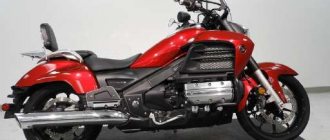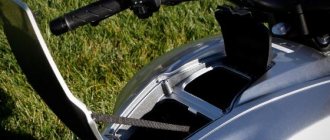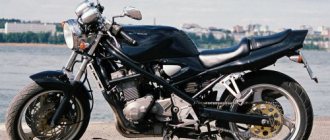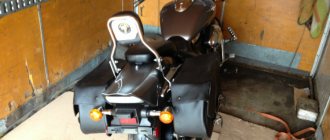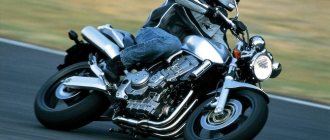Service
Motorcycle Maintenance Manual. Graphic PDF, English. ZIP archive (7.1M)
Maintenance Manual. Graphic PDF (good scan quality), English. ZIP archive (146M)
Maintenance Manual by Haynes. DJVU, English. ZIP archive (70.7M)
Honda VT600 device (microfiche). JPG (80 pictures). ZIP archive (2.7M)
VLX NV400Cp (NC26-120), VLX NV400Cr (NC26-130), VLX NV400CVs (NC26-139), VLX NV600Cp (PC21-120), VLX NV600Cr (PC21-130) Graphic PDF, Japanese. ZIP archive (7.1M)
VLS NV400CSw (NC37-100), VLX NV400CBw (NC26-164), VLX NV400CB1 (NC26-210/211/212) Graphic PDF, Japanese. ZIP archive (6M)
Full color wiring diagram. JPG (1.7M)
Electrical wiring diagram (minimum, for choppers). JPG (125.7k)
Electrical wiring diagram. Japanese. PDF (157.6k)
Device and principle of operation. DJVU, Russian. ZIP archive (7.3M)
Author: I.V. Xenophon. PDF, Russian. ZIP archive (28.6M)
Author: Grigoriev. Text PDF, Russian. ZIP archive (2M)
Text PDF, Russian. ZIP archive (1.2M)
Spare parts catalog (2 parts), List of specifications, Service information Graphic PDF, HTML. English, Japanese. ZIP archive (1.9M)
Learning to ride
Popular motorcycle safety book by Keith Code. Text PDF, Russian. ZIP archive (923k)
Effective street driving techniques, author: Lee Parks, translated into Russian: Frank (Serguei Tcherkassov). Text PDF. ZIP archive (7.8M)
Minimum information for a novice biker, project of the “Easy Rider” forum. Text PDF, Russian. ZIP archive (2.5M)
Quick Guide by Chevalier. Text PDF, Russian. ZIP archive (891.9k)
Source
Manual Honda Steed 400
Most recently, the Japanese motorcycle manufacturer provided domestic Honda users with a manual translated into Russian. This publication contains a lot of useful information and, in addition to the user manual, has a set of electronic circuits, photographs and color illustrations.
In addition, the Honda Steed 400 manual has several situations described in detail that may arise during operation. These are situations related to the transportation, maintenance or disposal of a motorcycle. Unfortunately, most motorcyclists do not consider this publication necessary, and only remember it when it turns out that the equipment is already out of order.
The manufacturer foresaw in advance that the Honda Steed 400 manual is suitable not only for a specific model, but for many existing motorcycles produced by this company. The developed user manual contains all the necessary data that should be used when repairing power unit mechanisms, starting, charging and ignition systems, and carburetors.
Also, using the manual, you can adjust and eliminate malfunctions of elements of the brake system, suspension, shock absorbers, and controls. In addition, the Honda Steed 400 manual contains a list of possible faults and various ways to fix them yourself.
The publication also contains useful information such as the dimensions of parts and the timing of their wear. The publication's appendix contains electrical circuit diagrams that are suitable for various modifications of Honda two-wheelers.
All actions that must be performed when carrying out repair work are presented in the form of color illustrations, accompanied by up-to-date comments and advice from professionals. This is very important when making repairs yourself, since if all instructions are followed, the risk of harming any of the motorcycle parts will be minimized.
To independently determine the malfunction of a technical device, you can refer to the diagnostic table, which indicates certain signs of most possible malfunctions. A list of probable faults is accompanied by possible ways to eliminate them.
It is worth noting that the manual is not a panacea. And it is advisable to study it before serious problems arise. If complex repairs are necessary, the manufacturers recommend contacting the official service centers of the Japanese manufacturer.
Source
Valve adjustment Honda VT 400 Shadow
Check the thermal valve clearances according to the service manual for your Honda VT 400 Shadow, as well as after disassembling the head or replacing the timing chain or when a characteristic “clunking noise” appears from the cylinder head.
Increased valve clearances lead to increased noise when the engine is running, and if the clearances are too small, the valves will not close, and the engine will not develop rated power, and sometimes it will be difficult to start.
Our service center provides:
Adjusting valves using a rocker mechanism Adjusting valves using washers (Washers are available for adjusting valves with a diameter of 7.48 mm and 9.48 mm)
Please note that after adjusting the valves, in some cases it is necessary to synchronize the carburetors
Honda Steed 400/600 motorcycle maintenance
There is very little information about servicing motorcycles intended exclusively for the Japanese domestic market. Their owners are saved by the fact that these “Japanese” have “Europeans” that are more or less similar in design to them. In this case, the instructions for the “close relative” of the Steed, the Honda Shadow with an engine displacement of 600 cm3, can be taken as a sample. They look like a “HORSE” AND HIS “REFLECTION”. Steed is translated from English as “horse”, and Shadow is “shadow”, “reflection”. Steed 600 is also close in design to the “four hundred” of the same name.
Any equipment requires at least minimal daily maintenance (DA). In relation to a motorcycle, this is an external inspection before each ride. Sometimes, noticing a leak or other problem can prevent a serious problem in time. rightness, or even an accident.
The frequency of maintenance can be found in the adjacent table. But behind each of its points lies a fairly large amount of work.
1. Fuel line. Remove the seat and fuel tank. Check the fuel hoses and fuel valve vacuum tube. If you notice damage or leaks, replace the faulty parts.
2. Throttle valve drive. Make sure that the cables move easily in the sheaths, are not pinched, and the sheaths themselves are not damaged. The gas handle, after turning to any angle, should return to its original position smoothly and without jamming. If any cable gets stuck, lubricate it with a special cable lubricant or at least motor oil. If it doesn't help, replace it. With the engine idling, turn the steering wheel left and right as far as it will go. If the speed increases, adjust or replace the cables. The free play of the throttle handle in the closed position should be 2-6 mm. If necessary, adjust it with the nuts on the cables.
3. The carburetor starting device (PU) (in models of 97-98 there are two carburetors and a double PU drive) is designed to enrich the fuel-air mixture when starting the engine. Its malfunction is indicated by: difficult starting of a cold engine and (or) randomly varying idle speed. These phenomena occur due to the enrichment of the mixture due to leakage of the PU valve. Its drive is often to blame. Adjust the drive cable so that the valve is pushed in all the way. If the cable sticks, lubricate it. If it doesn't help, replace it. It happens that the valve itself is leaking. Take it out and inspect it. If you find damage, replace it or the entire carburetor (sometimes replacing a carburetor with a working used one is more economical than replacing a valve).
4. Do not try to blow out or wash the air filter: change it no later than the specified period, and if you drive mainly on dusty roads, the mileage between replacements is reduced by one and a half to two times.
5. You need to clean out deposits from the crankcase ventilation more often if the motorcycle is often used in rainy weather, and after each fall. To find out if it's time for this dirty work, look at the clear section of the vent tube. It is located in front of the engine near the left frame pipe. If you see a lot of deposits, it’s time.
6. Inspect the spark plugs for damage and cracks on the insulators near the central electrodes. The carbon deposits on them should be light brown. If it is lighter, the carburetor is “poor”; if it is darker, it is “rich”; the spark plugs are oily - perhaps the engine needs repair. Recommended spark plugs are DPR8EA-9 (NGK) or X24EPR-U9 (Denso). The gap between the electrodes is 0.8-0.9 mm. Start twisting the candles by hand. Using a wrench, tighten with a force of no more than 1.4 kgm.
7. Valve clearances: intake - 0.15 mm; graduation - 0.20 mm. How to adjust the valves and synchronize the carburetors of the Honda Shadow VT500C engine (another “close relative” of the Honda Steed) is described in the material “Without a Single Shot” (“Moto”, No. 1-2006).
8-9. Engine oil, oil filter. Check the oil level before each ride and top up if necessary. Place the motorcycle upright on the center stand. When checking, do not twist the dipstick, but only insert it into the hole until it stops. If you fill oil above the upper mark, the engine power will decrease. If the level is too low, some engine and gearbox components will wear out quickly. Drain oil from a warm engine, but not from a hot one, to avoid getting burned. Recommended oils: Honda GN4 or SG category of other manufacturers with viscosity index SAE10W-40. Capacity (including filter) - 2.8 liters. On the forums they recommend taking a Motul 5100 4 liter canister. After replacement, start the engine, warm it up, turn it off and, after waiting 2-3 minutes, check the level again. If necessary, top up to maximum. Make sure there are no oil leaks.
Comparison with competitors in class
Comparing the Steed with the Kawasaki VN 400 Vulcan or Yamaha XV 400 Virago. We came to the conclusion that the bike is unkillable. As for the engine, it is rather weak compared to the competitors listed above. The comfort of riding and handling depends on the height of the rider. People taller than 185 cm feel uncomfortable driving, but a biker shorter than 185 cm feels comfortable.
Power, torque and V-twin engine make this chopper a favorite in its class among competitors Suzuki Intruder 400, Kawasaki VN 400 Vulcan, Yamaha XV 400 Virago.
Serviced units and parts. The item numbers coincide with the items in the table and text.
The letters in the table mean: 0 - inspect, clean, adjust, lubricate or replace if necessary; 3 - replace and nothing else; C - lubricate; C - clean.
*Special tools may be required to perform servicing operations on this unit. If the owner of the motorcycle does not have them or has little experience and technical knowledge, it is better to turn to specialists. ** Entrust the maintenance of these units and parts to specialists.
| Recommendations for servicing Honda Shadow 600 | |||||||||||
| Serviced node | Note | Maintenance frequency (whichever comes first) | |||||||||
| Mileage | 1 | 6 | 12 | 18 | 24 | 30 | 38,4 | ||||
| Months | 6 | 12 | 18 | 24 | 30 | 36 | |||||
| * | 1 | Fuel line | |||||||||
| * | 2 | Throttle valve drive | |||||||||
| 3 | Carburetor starter | ||||||||||
| 4 | Air filter | 2 | 3 | 3 | |||||||
| 5 | Crankcase ventilation | 3 | H | H | H | H | H | H | |||
| 6 | Spark plugs | 3 | 3 | 3 | |||||||
| * | 7 | Valve clearances | |||||||||
| Z | Engine oil | Z | Z | Z | Z | ||||||
| 9 | Oil filter | Z | Z | Z | Z | ||||||
| 10 | Carburetor synchronization | ||||||||||
| 11 | Idle speed | ||||||||||
| 12 | Coolant | 4 | |||||||||
| * | 13 | Cooling system | |||||||||
| 14 | Exhaust gas afterburning system | 5 | |||||||||
| 15 | Chain | Every 800 km O, C | |||||||||
| 16 | Brake fluid | 4 | Z | Z | |||||||
| 17 | Brake pad wear | ||||||||||
| 18 | Brake system | ||||||||||
| 19 | Brake light switch | ||||||||||
| * | 20 | Headlight adjustment | |||||||||
| 21 | Clutch drive | ||||||||||
| 22 | Side stand position sensor | ||||||||||
| * | 23 | Suspension | |||||||||
| * | 24 | Nuts, bolts, fasteners | |||||||||
| ** | 25 | Wheels and tires | |||||||||
| ** | 26 | Steering column play | |||||||||
DESIGNATIONS OF NUMBERS IN THE “NOTES” COLUMN:
1. If the motorcycle has high mileage or it is not known when and how it was serviced by previous owners, immediately replace the engine oil, oil and air filters, coolant and brake fluid. Lubricate the chain. Inspect and, if necessary, replace all components indicated in the table, and consider that you have completed the service at 6400 km. In the future, follow the repair intervals indicated in the table. 2. Maintenance should be performed more frequently if the motorcycle is used in very wet or dusty areas. 3. Clean this system more often if you have to drive in the rain. 4. These fluids should be changed every two years or according to the odometer reading, whichever comes first. 5. The system is only installed on motorcycles manufactured for Switzerland. And they are very rare in our country.
Source
Service
Motorcycle Maintenance Manual. Graphic PDF, English. ZIP archive (7.1M) Maintenance Manual. Graphic PDF (good scan quality), English. ZIP archive (146M)
Maintenance Manual by Haynes. DJVU, English. ZIP archive (70.7M)
Honda VT600 device (microfiche). JPG (80 pictures). ZIP archive (2.7M)
VLX NV400Cp (NC26-120), VLX NV400Cr (NC26-130), VLX NV400CVs (NC26-139), VLX NV600Cp (PC21-120), VLX NV600Cr (PC21-130) Graphic PDF, Japanese. ZIP archive (7.1M)
VLS NV400CSw (NC37-100), VLX NV400CBw (NC26-164), VLX NV400CB1 (NC26-210/211/212) Graphic PDF, Japanese. ZIP archive (6M)
Full color wiring diagram. JPG (1.7M)
Electrical wiring diagram (minimum, for choppers). JPG (125.7k)
Electrical wiring diagram. Japanese. PDF (157.6k)
Device and principle of operation. DJVU, Russian. ZIP archive (7.3M)
Author: I.V. Xenophon. PDF, Russian. ZIP archive (28.6M)
Author: Grigoriev. Text PDF, Russian. ZIP archive (2M)
Text PDF, Russian. ZIP archive (1.2M)
Spare parts catalog (2 parts), List of specifications, Service information Graphic PDF, HTML. English, Japanese. ZIP archive (1.9M)
Honda Steed 400/600 motorcycle maintenance
There is very little information about servicing motorcycles intended exclusively for the Japanese domestic market. Their owners are saved by the fact that these “Japanese” have “Europeans” that are more or less similar in design to them. In this case, the instructions for the “close relative” of the Steed, the Honda Shadow with an engine displacement of 600 cm3, can be taken as a sample. They look like a “HORSE” AND HIS “REFLECTION”. Steed is translated from English as “horse”, and Shadow is “shadow”, “reflection”. Steed 600 is also close in design to the “four hundred” of the same name.
This year I bought a 15-year-old Honda Steed 400 with 30 thousand km on it. I live in a small town where there are no motorcycle services - I have to do all the maintenance myself. The trouble is that I know very little about this motorcycle and cannot find any information about it. Please tell us what kind of oil and how much to pour into the engine, how much antifreeze to pour, how to adjust valves, carburetors, ignition, as well as other details regarding the maintenance and repair of this motorcycle. Marina MOROZOVA, Vladimir region.
Any equipment requires at least minimal daily maintenance (DA). In relation to a motorcycle, this is an external inspection before each ride. Sometimes, noticing a leak or other problem can prevent a serious problem in time. rightness, or even an accident.
The frequency of maintenance can be found in the adjacent table. But behind each of its points lies a fairly large amount of work.
1. Fuel line. Remove the seat and fuel tank. Check the fuel hoses and fuel valve vacuum tube. If you notice damage or leaks, replace the faulty parts.
2. Throttle valve drive. Make sure that the cables move easily in the sheaths, are not pinched, and the sheaths themselves are not damaged. The gas handle, after turning to any angle, should return to its original position smoothly and without jamming. If any cable gets stuck, lubricate it with a special cable lubricant or at least motor oil. If it doesn't help, replace it. With the engine idling, turn the steering wheel left and right as far as it will go. If the speed increases, adjust or replace the cables. The free play of the throttle handle in the closed position should be 2-6 mm. If necessary, adjust it with the nuts on the cables.
3. The carburetor starting device (PU) (in models of 97-98 there are two carburetors and a double PU drive) is designed to enrich the fuel-air mixture when starting the engine. Its malfunction is indicated by: difficult starting of a cold engine and (or) randomly varying idle speed. These phenomena occur due to the enrichment of the mixture due to leakage of the PU valve. Its drive is often to blame. Adjust the drive cable so that the valve is pushed in all the way. If the cable sticks, lubricate it. If it doesn't help, replace it. It happens that the valve itself is leaking. Take it out and inspect it. If you find damage, replace it or the entire carburetor (sometimes replacing a carburetor with a working used one is more economical than replacing a valve).
4. Do not try to blow out or wash the air filter: change it no later than the specified period, and if you drive mainly on dusty roads, the mileage between replacements is reduced by one and a half to two times.
5. You need to clean out deposits from the crankcase ventilation more often if the motorcycle is often used in rainy weather, and after each fall. To find out if it's time for this dirty work, look at the clear section of the vent tube. It is located in front of the engine near the left frame tube. If you see a lot of deposits, it’s time.
6. Inspect the spark plugs for damage and cracks on the insulators near the central electrodes. The carbon deposits on them should be light brown. If it is lighter, the carburetor is “poor”; if it is darker, it is “rich”; the spark plugs are oily - perhaps the engine needs repair. Recommended spark plugs are DPR8EA-9 (NGK) or X24EPR-U9 (Denso). The gap between the electrodes is 0.8-0.9 mm. Start twisting the candles by hand. Using a wrench, tighten with a force of no more than 1.4 kgm.
7. Valve clearances: intake - 0.15 mm; graduation - 0.20 mm. How to adjust the valves and synchronize the carburetors of the Honda Shadow VT500C engine (another “close relative” of the Honda Steed) is described in the material “Without a Single Shot” (“Moto”, No. 1-2006).
8-9. Engine oil, oil filter. Check the oil level before each ride and top up if necessary. Place the motorcycle upright on the center stand. When checking, do not twist the dipstick, but only insert it into the hole until it stops. If you fill oil above the upper mark, the engine power will decrease. If the level is too low, some engine and gearbox components will wear out quickly. Drain oil from a warm engine, but not from a hot one, to avoid getting burned. Recommended oils: Honda GN4 or SG category of other manufacturers with viscosity index SAE10W-40. Capacity (including filter) - 2.8 liters. After replacement, start the engine, warm it up, turn it off and, after waiting 2-3 minutes, check the level again. If necessary, top up to maximum. Make sure there are no oil leaks.
10. Synchronization of carburetors. This work will require special equipment - entrust it to specialists.
11. Adjusting idle speed. Connect the tachometer, warm up the engine and set the speed screws to 1200 ± 100 rpm.
12. Coolant. Check the level in the tank regularly - it should be between the upper and lower marks. Open the reservoir cap only when the engine is cool - otherwise the antifreeze will splash out and burn your hands! Add a mixture of antifreeze concentrate and distilled water in a 1:1 ratio. Do not use regular tap water - it may damage the engine. Change the fluid every two years or as directed on the fluid bottle. The total capacity of the cooling system (radiator, engine, expansion tank) is 2 liters.
13. Cooling system. Before starting work, disconnect the negative terminal of the battery. If you do not do this, the fan will turn on regardless of the position of the ignition key and can cause injury. Blow out the radiator with compressed air from the inside. If there are a lot of insects stuck in it, soak them up with a stream of water from a hose (but do not use high-pressure washers!). If it doesn’t help, carefully remove them with a thin screwdriver. Check for leaks. Replace hoses that have cracks. When finished, be sure to reconnect the fan. Do not allow the fluid level in the reservoir to drop below the minimum level as air may enter the system. And if it does get in, then to get it out, remove the expansion tank cap and start the engine. Open the gas sharply 2-3 times and close the lid.
A little history of the model
Although the Honda Steed 400 motorcycle models were initially produced for the domestic market, over time they decided to release it on other continents. The production of this motorcycle began in 1988.
And this model existed until 2001.
We can say that this motorcycle has two generations in its history.
The first generation was produced until 1996, then the second generation was produced.
Although the division into generations of this motorcycle can be considered conditional, since no special changes were made to the design, there were only minor changes in appearance.
In addition, the Steed 400 motorcycle line has 4 versions. The regular version of the motorcycle had the letter VLX in its designation.
This version of the motorcycle was produced throughout all years of production. There was also a VLS model.
This model, unlike the standard one, had a chrome-plated springer front suspension. This made it possible to install a 21-inch front wheel on the motorcycle.
In addition, the saddle height of this version was 20 mm lower than the standard one. This model was produced from 1996 until the end of production.
There was also a model designated VSE. The only difference from the base model was the rear wheel.
This version was equipped with a solid disc instead of a spoke one. The latest version was designated as VCL, the full version name was Custom Edition.
Learning to ride
Popular motorcycle safety book by Keith Code. Text PDF, Russian. ZIP archive (923k)
Effective street driving techniques, author: Lee Parks, translated into Russian: Frank (Serguei Tcherkassov). Text PDF. ZIP archive (7.8M)
Minimum information for a novice biker, project of the “Easy Rider” forum. Text PDF, Russian. ZIP archive (2.5M)
Quick Guide by Chevalier. Text PDF, Russian. ZIP archive (891.9k)
Service manual for Honda Shadow / Steed 600/400 (1988-1996). Book in Russian, 287 pages. Repair and maintenance manual for motorcycles Honda Shadow / Steed 600/400 (1988-1996). Contains instructions for disassembling and reassembling all motorcycle components, setup and troubleshooting procedures, and an electrical diagram.
Features of HONDA Shadow 400
In terms of its parameters and appearance, the HONDA Shadow 400 is a typical classic cruiser.
Apart from interesting decisions regarding changing the chassis, the bike has few differences.
- Suspension with short travel that cannot be adjusted.
- 2 springs on the rear shock absorber provide a soft ride, but they also make their way with a bang even with a small load (it’s better not for two burly men to sit on this bike together).
- A motorcycle for the city - it’s better not to meddle with the Moscow Ring Road with its flow speeds.
- The chopper seat allows you to change the position of your legs when driving, and the soft sofa allows you to cover significant distances in “one sitting.”
Honda VFR 400R NC24
Manual and service book for the Honda VFR 400R NC24 motorcycle – Description: This manual is in the form of JPG pictures of pages torn from the book, it is very difficult to find such a manual . During the reign of the Honda VFR 400R NC24 , manuals simply weren’t issued yet, as they are now... so although this is not a large manual, it is extremely difficult to find. The manual for the Honda VFR 400R NC24 was provided and sent by Cerber. If you have time, please leave a comment and thank this wonderful person (either here or on the motorcycle forum ) To download the manual for the Honda VFR 400R NC24, click here (and don’t forget to leave a comment!) |
(understand only english?) Click over here for download manual book for Honda VFR 400R NC24 , after, leave a comment, thx.
Also for the Honda VFR 400R NC24 motorcycle you can download microfiches - these are sheets on which each part is thoroughly disassembled and has its own number (usually needed to order spare parts for a motorcycle ) Download microfiches for Honda VFR 400R NC24 | (understand only english?) Click over here for download microfiches for Honda VFR 400R NC24 , after, leave a comment, thx.
Source
Honda VFR 800 Fi Interceptor (1998-2002)
Manual Repair ( repair book for the Honda VFR 800 Fi Interceptor motorcycle from 1998 to 2002 ) The manual service book in *.rar and divided into 3 parts, two 89 MB each, the last 3 MB, use RAR by newer, unless suddenly unzipped. Link 1 to download the manual Link 2 to download the manual Link 3 to download the manual
If you have a need for any spare parts for the Honda VFR 400R NC24 / NC30 , also for the Honda VFR 800 Fi Interceptor (1998-2002) >, and basically for any other motorcycle
